Rice is a staple food for an ever-growing human population, but growing this precious grain strongly affects our environment. Rice farming practices are resource-demanding and a potent source of greenhouse gases, contributing approximately 11% of the global anthropogenic methane emissions. To address this issue, I recently contributed to a study that looks at how we can adapt traditional rice farming techniques to reduce these emissions.
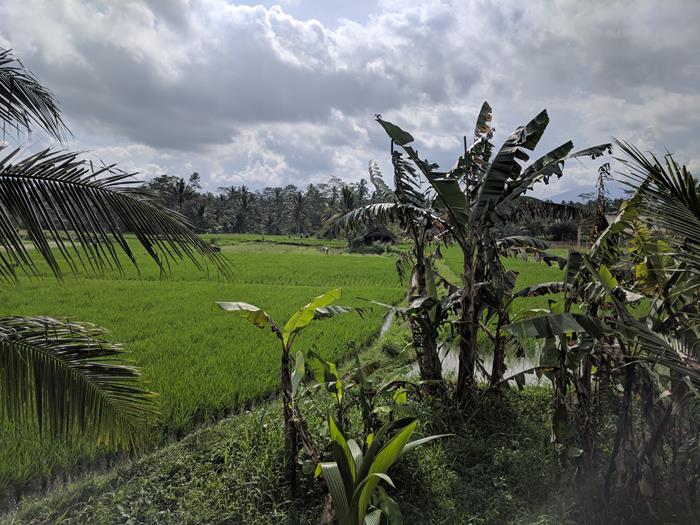
A rice field in Subak Bene, Kecamatan Marga, Tabanan, Bali Indonesia, where the study was conducted (Source: Sharadha Sathiakumar/Nanyang Technological University, Singapore)
I started working on this topic as a graduate student at the Asian School of the Environment (ASE) and the Earth Observatory of Singapore (EOS) at Nanyang Technological University, Singapore (NTU Singapore). During engaging discussions with my supervisor, Professor Steve Lansing, who was the former director of the NTU's Complexity Institute and a Professor at ASE, we explored potential solutions to mitigate greenhouse gas emissions in the rice fields of Bali located in Indonesia, the fourth-largest producer of rice worldwide.
In a study led by Prof Lansing and published in Philosophical Transactions of the Royal Society B: Biological Sciences, we show that it is possible to increase rice yields while keeping greenhouse gas emissions low. We used an adaptive form of the Intermittent Wetting and Drying (IWD) technique that alternates periods of flooding and drying throughout the growing season. Here, we allowed the farmers to choose the rewetting schedule in a way that effectively reduces the duration when the rice paddies are flooded, which is when methane production primarily occurs.
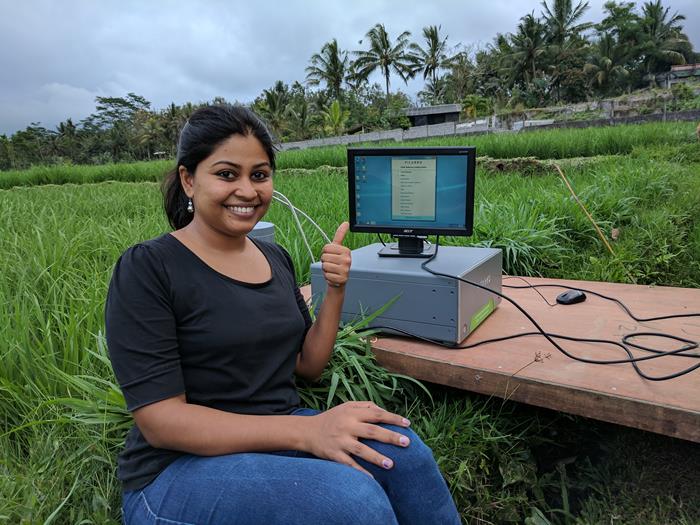
Dr Sharadha Sathiakumar conducting part of the study in Bali (Source: Nanyang Technological University, Singapore)
A burgeoning agricultural practice sparked our interest, the Intermittent Wetting and Drying (IWD) technique, as it demonstrated promising results in reducing methane emissions. Previous findings reported a notable decrease of over 60% in methane output, showcasing its potential as an environmentally sustainable farming method on a global scale.
Our primary goal was to confirm these findings. We used a high-precision gas analyser to measure emissions from a standard protocol of rice farming and compare the results against emissions from an IWD schedule in small test plots in Bali. The use of an in-situ gas analyser allowed us to measure methane and nitrous oxide gases simultaneously, accurately and through time from both setups. This led us to unravel the intricate workings of the IWD technique. From these initial set of experiments, we found that, while IWD reduced methane emission due to reduction in flooding periods, the intermittent wet periods triggered spikes in nitrous oxide emission, another potent greenhouse gas. This meant that, overall, this technique was still not ideal for achieving our goal of making rice production environmentally sustainable.
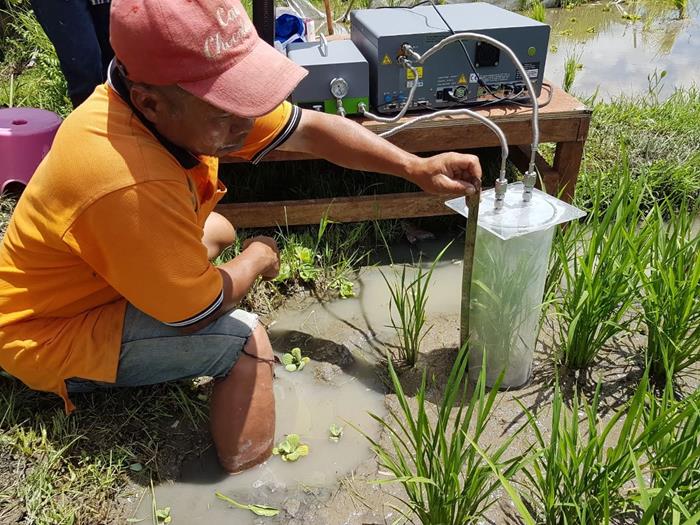
A local farmer conducting experiments using the Intermittent Wetting and Drying Technique (Source: Sharadha Sathiakumar/ Nanyang Technological University, Singapore)
An adaptive alternate wetting and drying technique
To strike a balance between the reduction in methane, which occurs by drying the field, and the emission of nitrous oxide, which happens when rewetting, we set out to test an adaptive form of the IWD that did not predetermine an irrigation schedule. Rather, we allowed the farmers to make informed decisions about their respective rewetting schedules based on the soil condition. For example, small cracks appearing in the soil meant that the soil was dry and needed water. This adaptive technique encouraged only brief periods of wet conditions. The results of this experiment were very promising: both methane and nitrous oxide emissions reduced, and rice yield increased. By analysing the soil and plant morphology, we discovered that the rice roots were absorbing more nitrogenous fertilizer, which benefited the plants.
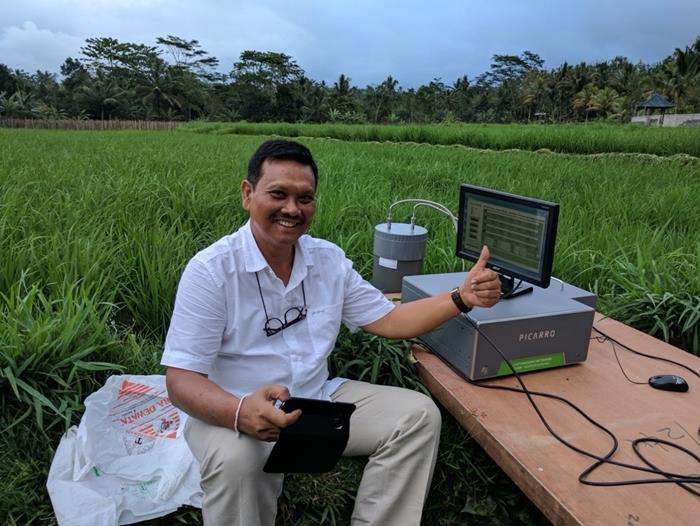
I Wayan Alit Artha Wiguna, one of the co-authors of this study (Source: Sharadha Sathiakumar/ Nanyang Technological University, Singapore)
Bringing our results to Balinese farmers
In Bali, a team of local and international researchers involving some of our collaborators raised awareness of this adaptive method and explained its environmental and economic benefits, with a deep understanding that, like in many Asian rice-growing countries, Balinese agricultural practices are rooted in tradition and culture. This includes a 1000-year-old tradition of rice farming that has established complex irrigation networks called Subaks, which decide the irrigation and fertilizer schedule for regional-scale farms.
Eighteen farmers from Subak Bene volunteered to test this method, while eighteen others agreed that their farms could serve as test plots. This community experiment was highly encouraging—both the rice quality and the yield increased. The method allowed farmers to decide on their own irrigation schedules, taking advantage of a robust and self-governing capacity of the Subaks that has continuously adapted and thrived for a thousand years. This ensured the farmers were part of the process, and that the process took place robustly and sustainably. Today, this method is gaining popularity rapidly through word-of-mouth, as farmers look forward to adopting an environmentally friendly approach that increases rice yields.
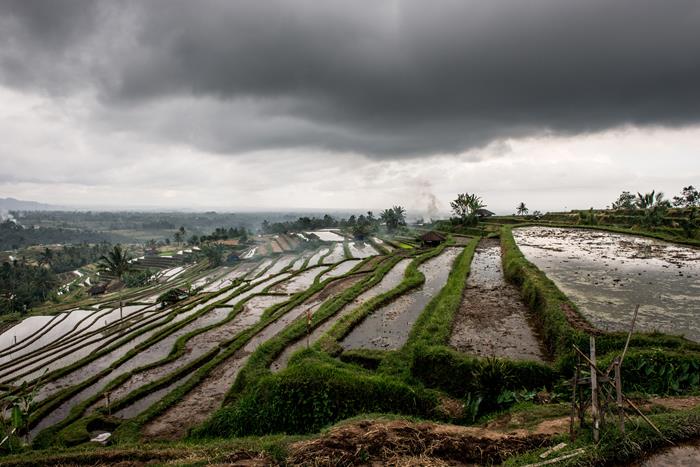
Terraced rice fields are a component of the Subak system (Source: Joanne Petrina/ Earth Observatory of Singapore)
One of the exciting lessons and reminders from our study is that while climate change mitigation is an imminent need in today's changing climate, making it practical and feasible involves working collaboratively with existing cultural and socio-economic frameworks with an open mind to generate sustainable solutions. The success of this method in Bali can also help reform agricultural practices in other rice-growing nations and reduce greenhouse gas emissions globally from rice cultivation.
Special thanks to Prof Dr Wayan Alit Artha Wiguna and his colleagues at the Agricultural Instrument Standards Agency of Bali Province, for helping conduct these experiments.